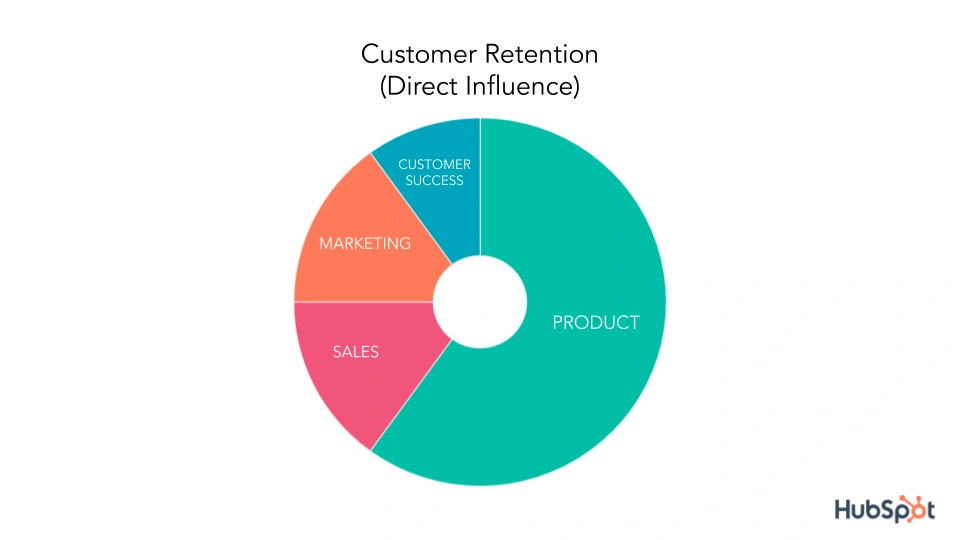Customer Success Is a Team Sport
One day, a product manager at HubSpot popped into the room.
I was listening to recordings of my calls, trying to find a better way to talk to customers.
He laughed.
“Churn is a team problem, and the customer success department acts as the captain,” he said. "They don't single-handedly carry the team."
He described the multiple players on the company “team”: Product, Marketing, Sales, and Customer Success. Each team plays a role in customer success and retention.
But some, he said, have direct influence — the work they do immediately improves customer retention.
At a product-driven company, he estimated the engineering team has about 60% direct influence on retention, as product quality contributes most directly to the customer experience.
Sales and marketing have 15% direct influence each by targeting good-fit customers and using the right messaging, respectively.
My team, the customer success department, has 10% direct influence through consultative interactions with the customer.
-1.png?width=1500&name=On-Brand%20Image%20Template%20(2)-1.png)
I was pretty disheartened. The department I was heading — that was created to raise customer retention — had the least control over that number?
He explained that the indirect influence of customer service is critical, since customer conversation insights inform the rest of the company. It’s like the product team is the car’s engine, and the customer success team is the gas.
 His words helped me break down my job as a Customer Success Manager. I first had to fulfill my direct influence responsibilities by talking to customers and maximizing that 10% influence. My second priority was using each conversation with customers to better understand their needs — and sharing those with others.
His words helped me break down my job as a Customer Success Manager. I first had to fulfill my direct influence responsibilities by talking to customers and maximizing that 10% influence. My second priority was using each conversation with customers to better understand their needs — and sharing those with others.
With that in mind, our team starting sending a weekly email called the Voice of the Customer. This email summarized the trends we were hearing on the phone. We also included a list of the top “blockers” to a customer’s activation and expansion with our product. For teams that didn’t interact directly with customers, this newsletter was their primary way to understand the customer experience.
The email evolved over time as different stakeholders requested changes to their sections — and grew so popular we created an automation subscription page.
So, what's up with the voice of the customer (VoC)? Why is it so important, and how can entire organizations — and not just the customer success team — use it to drive results and improve retention?
Read on to learn more about VoC and how organizations are capturing and using it.
What is the voice of the customer?
The voice of the customer (VoC) is the process of listening to customer feedback about their experience using a product or service, sharing results within the organization, and interpreting feedback to improve customer experience and retention.
This process looks different for every organization. In my case here at HubSpot, we shared VoC with something as simple as an email subscription.
However, it's critical that the final results of this customer perspective with the broader organization — not just the customer success team. As I learned from the diagrams above, my team isn't the only one playing a role in if a customer stays or churns.
Why the Voice of the Customer is Important to Customer Retention
Voice of the customer is critical to customer retention because customer success is a team sport. Building a customer success team is an important piece of the puzzle, but it's just one piece of the solution to improving customer retention and helping them see value from your products or service.
Before you start building your customer success puzzle, you must collect customer feedback. Using any survey methodology you like, or even by asking for qualitative feedback one-off on a phone call, front-line customer service reps and customer success managers (CSMs) will likely be the primary source of customer feedback.
Other sources of customer feedback could come from marketing email campaigns, social media messages or comments, or by analyzing the rate of use of certain tools, products, or apps.
Additionally, measure your customer service metrics to track your progress. Consider a customer feedback tool like HubSpot to help send surveys and track customer experience over time.
Product
Without the voice of the customer, your organization's product team doesn't have a starting point from which to change and improve things. From the team's perspective, they could be building a product or software that's too hard-to-use — or doesn't solve the problems your customers are trying to solve.
By sharing detailed feedback on the types of questions customers ask the customer success team once they begin onboarding with the new product or service, Customer Success can enable Product to make updates and changes that provide solutions before the customer grows frustrated — and prevents them from churning.
Marketing
Marketing teams are tasked with creating compelling content and campaigns that work leads through the funnel to generate marketing-qualified leads (MQLs) for the sales team. And sometimes the message might not match the end result when a lead has converted into a customer and starts using the product they saw ads or read blog posts about.
Marketing teams are also only tasked with generating new leads for the sales team — and not with creating content and campaigns for customers, who can generate new leads and loyal customers free of charge, by way of referral marketing.
VoC can be used by Marketing to create content for them — which, in turn, helps customers succeed, and incentivizes them to become brand evangelists and refer friends.
Sales
Salespeople are motivated by generating more revenue for the business, and without a service-level agreement (SLA) in place, your sales team might be bringing in new customers that don't succeed and churn as a result.
Sales should use feedback shared by the Customer Success team to help inform the sales incentive plan. For example, if customers are more successful and see more value from using two products or services in tandem, salespeople should be incentivized to upsell customers on those benefits so CSMs can help them derive more value further down the line.
Customer Success
And last, but certainly not least, the VoC is critical to the customer success team itself.
Customer success is a team sport that should be played by every team in your organization to improve retention, but when it comes down to it, the customer success manager is the captain — tasked with collecting and analyzing customer feedback collected through surveys, comments, and conversations, and informing the other teams so they can adjust their strategies to bring more value to your customers.
Sharing this information within your team helps you improve calls and conversations with your customers, but bringing the voice of the customer to your entire organization — like we did with our email — helps everyone work to improve customer retention by helping customers see value and grow revenue by using your product or service.
A version of this blog post originally appeared on LinkedIn.
Editor's note: This post was originally published in November 2017 and has been updated for comprehensiveness.
Customer Retention
.png?width=112&height=112&name=Image%20Hackathon%20%E2%80%93%20Vertical%20(85).png)


-2.png)
![7 Customer Acquisition Challenges You Might Face This Year [New Data]](https://53.fs1.hubspotusercontent-na1.net/hubfs/53/customer%20acquisition%20%20(1).webp)




![7 Secrets for Getting Repeat Customers That Stick Around [Consumer Data]](https://53.fs1.hubspotusercontent-na1.net/hubfs/53/repeat-customers.jpg)


